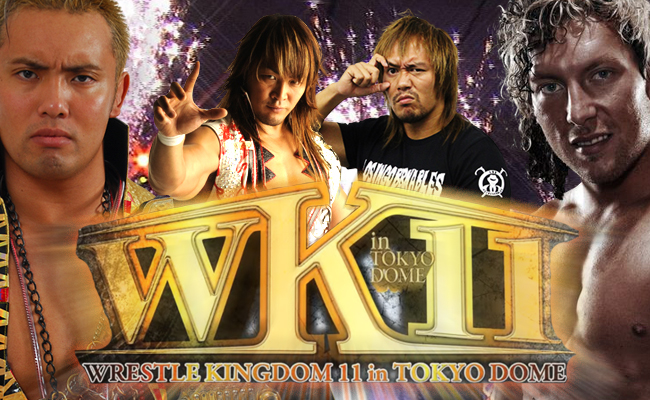
We are mere hours away from the biggest event of the Japanese pro wrestling year; what is for many of us our WrestleMania, our Christmas Day.
This guide is for the fans that have, time and time again, expressed interest in following New Japan Pro Wrestling, but are having trouble finding a way in. While we are working on a more comprehensive, detailed guide to the history of New Japan and its characters, here we will cover all the wrestlers, matches, championships and stories related to this year’s Wrestle Kingdom pay-per-view, giving you everything you need to get up to speed before the big show.
NJPW Wrestle Kingdom 11 in Tokyo Dome is live on New Japan World, Wednesday January 4th at 1:30 AM EST, and WZ will be providing complete coverage of the event as it airs live in the U.S. late night tonight.
New Japan And How To Watch
New Japan Pro Wrestling, established in 1972 by Antonio Inoki, is the biggest wrestling promotion in the country of Japan. Globally, they have the second largest audience after WWE.
Their biggest event of the year takes place at the Tokyo Dome, and has run every year on January 4th since 1992 without interruption. On six occasions the annual Tokyo Dome show out-drew WWE’s WrestleMania pay-per-view taking place in the same year. In 2007 the event was re-branded as “Wrestle Kingdom in Tokyo Dome”, broadcast on pay-per-view, and since 2015 has featured a separate stream with English commentary as a part of their expansion towards western audiences.
This year, Wrestle Kingdom 11 will be broadcast live on New Japan World, the promotion’s online streaming service comparable to the WWE Network. The show will feature commentary from long-time Ring of Honor announce duo Kevin Kelly and Steve Corino, in their final broadcast together.
The first step is to sign up for a New Japan World account at NJPWworld.com. The monthly fee is 999 yen (yes, they did that on purpose), which depending on the current exchange rate is around $8.50. Unlike the WWE Network, you’ll be billed on the first of every month, so keep that in mind. Be prepared for your first hurdle in bridging that gap as a western fan trying to convert: the website is in Japanese, but the automatic translator on your web browser should help ease that pain. They’ve also recently added a Paypal option for check-out, which will take you to an English website to use your credit card. Once your done, Paypal will redirect you back to World, and you’ll be ready to go. If you have any issues or questions, there are plenty of easily accessible guides and videos online to help you through it.
Once you’re subscribed you’ll have access to virtually every show New Japan has ever run, including every Tokyo Dome and Wrestle Kingdom event, and the annual G1 Climax tournaments that many of us used to pay a LOT of money to watch at a per-show rate.
Ready for your second hurdle? Time zones are a thing. New Japan shows run around the same time locally as WWE events, which means they don’t start until well after midnight on the U.S. east coast, and run into the early morning. While that’s not the biggest issue for us nocturnal people, for those of you with regular jobs and families all the events are uploaded to watch on-demand at your convenience.
Now, the second biggest question we get after “how the heck do we watch this stuff?” is easily “what other shows do they put on, and which ones should I be watching?” New Japan does have weekly shows locally, but they are a collection of matches and interviews from their bigger monthly events, so there’s no Monday Night Raw or Impact Wrestling to keep track of every week. In many ways that’s a good thing, because as a western fan it makes New Japan very easy to follow as the time investment is minimal, outside of tournaments.
They run big events usually once or twice per month, with “Road To…” tours that are almost exclusively house shows, although some of the house shows are uploaded to World later with a single camera perspective and no commentary. They’re not really necessary unless you’re a hardcore fan or want to see a specific match, and we’ll cover any angles worth mentioning here to keep you updated.
January is a big month for New Japan. The first show is actually the day after Wrestle Kingdom, called New Year Dash. It’s mostly tag team matches, but it’s pretty cool because it’s the only show of the year where the matches aren’t announced in advance, and it generally features a lot of angles to set up new programs. For instance, the 2016 New Year Dash saw the Bullet Club turn on AJ Styles on his way to WWE, and the promotion of Kenny Omega to the heavyweight division and his installment as the new leader of the Bullet Club. There’s also a just-for-fun series of shows called Fantasticamania later in the month, which showcase talent from New Japan’s Mexican partner promotion CMLL.
Hurdle number three. Let’s talk commentary. The majority of New Japan shows don’t have English commentary. Because of their partnership with Ring of Honor and attempt to expand westward, the number of shows that do is growing, but most of the year you’re not going to understand what the announcers are saying unless you speak Japanese. For some people that’s a problem. It was for me at first, when I started watching regularly, but the more you come to understand the wrestlers and their stories, the less of an issue it really becomes. The Japanese commentators are passionate, and after a few shows you’ll start losing yourself in the matches. Wrestle Kingdom, New Year Dash, the final nights of the G1 Climax, and the October King of Pro-Wrestling events all had English commentary in 2016.
And that should be all you need to know from a technical point of view. If you have any specific questions feel free to leave them in the comments section below and I’ll be around to help.
Terms You Need To Know
IWGP: Stands for “International Wrestling Grand Prix”. It is the governing body of New Japan (think the WWE Board of Directors), and one of the early names of the annual tournament that would eventually be re-branded as the G1 Climax.
Puroresu: Literally the shortening of the Japanese pronunciation of “pro wrestling”.
Gaijin: Literally “foreigner”. The term given to foreign wrestlers, generally from the west, generally portraying villains.
Juniors: In New Japan the roster is divided into “juniors”, wrestlers under 220 pounds, and “heavyweights”. While traditionally cruiserweights in WWE and WCW wrestled a style heavily influenced by lucha libre – although that has changed somewhat with the rebirth of the division in 2016 – the term “juniors” is more to split up the weight classes. While their smaller size does lend itself to more high-flying and acrobatic wrestling, you also have guys that utilize more counters, submissions, grapples, etc.
Strong-Style: You’ve probably heard this term before, possibly from New Japan veteran turned NXT Champion Shinsuke Nakamura. It refers to a specific style of wrestling based around the founder of New Japan, Antonio Inoki, who utilized a lot of stiff strikes and kicks, as well as submissions in his repertoire. It’s an old school, no-nonsense mentality, and a lot of times you’ll notice with the wrestlers that hold to it that their matches seem more physical and realistic; in a lot of ways it blends pro wrestling with MMA, which was what Inoki tried to do before being removed from New Japan in the mid-2000s.
G1 Climax: This isn’t directly necessary for understanding Wrestle Kingdom, but we get asked about it a lot. G1 Climax is an annual event that dates back to the World League tournament in 1974. Its current incarnation is a round robin style tournament with 20 wrestlers split into two brackets. Over the course of several weeks a participant will face every wrestler in his bracket, being awarded points for winning, with the winners from each bracket facing off on the final night. The G1 is the most physically demanding, and most respected tournament in pro wrestling; before they extended the length to allow for more days off in between shows, injuries were common and guys had to drop out early due to the strain of wrestling your best matches of the year nearly ever single night for weeks on end. Main event talents see it as a way to further their legacies, up-and-comers are given a chance to establish themselves as major players on the roster, and aging veterans can find new life. In recent years, the winner of the G1 Climax has been awarded the main event at Wrestle Kingdom, generally in the IWGP Heavyweight Championship match.
20-Count: Unlike most western promotions, New Japan uses a 20-count when wrestlers leave the ring. This allows them more time to work freely around the ring, selling injuries, and setting up big spots.
Disqualification: In general, New Japan referees are more lenient and tend to not throw out matches as quickly as WWE referees. Although the bigger difference is that there’s not nearly as much interference or cause for DQ in most New Japan matches. Big spots are usually saved for important main event matches and are used sparingly to maximize their effect.
Young Lion: New Japan trains its young talent in the New Japan Dojo, during which they appear as ring crew (helpers around the ring) on main roster shows. Upon graduating they become Young Lions, and work on the undercard in tag team matches, gaining valuable experience alongside veteran performers until they are ready to be promoted to full-fledged roster members. During their Young Lion period, wrestlers are not allowed to have gimmicks, generally do not have specific finishing moves, and wear basic black boots and trunks in their matches. Jay White, who currently works for Ring of Honor, was a Young Lion throughout 2015 before being promoted and sent to ROH on an excursion to hone his craft globally. This is a common practice in New Japan, as virtually ever major name in the promotion has left for an extended period to work in Mexico, the United States or the UK only to return a few years later with a new gimmick in a better role.
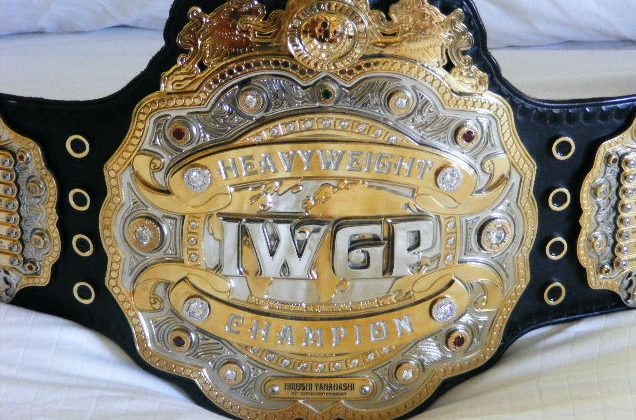
Championships of New Japan
IWGP Heavyweight Championship: This is the major world title of New Japan Pro Wrestling. Of course everyone has their own favorite promotions, but due to the consistent quality of matches and New Japan booking only putting deserving main event level talent in title matches, the championship is widely regarded as the most respected title in the world. In short, being a “former IWGP Heavyweight Champion” means something.
IWGP Jr. Heavyweight Championship: The top prize for any juniors star in New Japan. The list of former champions, especially during the late 1980s to mid-1990s, is a collection of some of the top wrestlers in the world. Names like Owen Hart, Chris Benoit, Jushin Thunder Liger, Ultimo Dragon, Minoru Tanaka and Kota Ibushi populate its record books.
IWGP Tag Team Championships: Fairly self-explanatory. Interestingly, since 2007 with a few exceptions, the heavyweight tag titles have been dominated by gaijins teams. Team 3D and the British Invasion kicked this off during New Japan’s partnership with TNA, followed by a 564-day title reign by Giant Bernand (Matt Bloom) and Karl Anderson, before the formation of Bullet Club. Over the last three years, two teams from Bullet Club have had five reigns with the belts.
IWGP Jr. Tag Team Championships: The tag team titles specifically for the juniors division. Since 2013 the titles have basically become a play house for the Young Bucks, who are in their fifth reign.
IWGP Intercontinental Championship: This title was created in 2011 during the first ever New Japan tour of the U.S. It was mainly a midcard title for awhile, not unlike the WWE title of the same name, until established main eventer and former world champion Shinsuke Nakamura won it. Because of the consistent greatness of his matches and the love fans have for Nakamura, the IC title was elevated to at one point being on par with the Heavyweight Championship. In 2014, New Japan’s top star Hiroshi Tanahashi defeated Nakamura in the main event of that year’s Tokyo Dome show for the title, taking top billing over the Heavyweight Championship. After Nakamura left for WWE in 2016, the title helped launch Kenny Omega into the main event, and further established Michael Elgin before he lost it to current champion Tetsuya Naito.
NEVER Openweight Championship: The NEVER project was launched in 2010 as a way for New Japan to feature both up-and-coming stars and wrestlers from other promotions that they could sign later. It was not dissimilar to the original idea behind WWE NXT. The NEVER project is also open to wrestlers from both weight classes. Eventually the NEVER-exclusive shows were abandoned, and the belt has since become a place for the third generation veterans to do something semi-relevant on the card. Because Katsuyori Shibata, Yuji Nagata, Tomoaki Honma, Tomohiro Ishii and Togi Makabe have been the primary contenders in recent years, it has basically become the Strong Style Championship.
NEVER 6-Man Tag Team Championships: Established in 2016, this is New Japan’s version of a trios division, featuring three men on each team instead of the traditional two. With eight different reigns in one year, and virtually no elevation of the stars that held them, these titles are easily the least important on the roster.
Wrestle Kingdom 11
Pre-Show: New Japan Rumble
The New Japan Rumble has become the annual pre-show match for Wrestle Kingdom over the last few years. It is a Battle Royal with over-the-top-rope rules, with wrestlers not otherwise booked on the show, and traditionally features a few surprise returns. In 2016 Great Kabuki, Hiro Saito, King Haku, Shiro Koshinaka (the first IWGP Jr. Champion) and a 66-year-old Yoshiaki Fujiwara (creator of the Fujiwara armbar) all made surprise appearances.
Confirmed: Hiroyoshi Tenzan, Jushin Thunder Liger, Manabu Nakanishi, Ryusuke Taguchi, Tiger Mask and Yuji Nagata.
Tiger Mask W vs. Tiger The Dark
This is basically a throwaway match to promote the Tiger Mask W anime, which New Japan has a hand in producing, and which features several New Japan wrestlers. This has only happened once before, and while not confirmed officially it’s widely believed that Kota Ibushi is behind the Tiger Mask W outfit, which has to be an intentional joke because it would be like Bray Wyatt leaving WWE, and then coming back on the WrestleMania pre-show under a cartoon mask for a five-minute comedy match. It’s very likely this will be moved to the pre-show.

IWGP Jr. Tag Team Championship
The Young Bucks (c) vs. Roppongi Vice
The Young Bucks are in their fifth reign as champions. They’re also the current Ring of Honor and PWG tag team champions. If you haven’t at least heard of them, or seen a ridiculous GIF of one of their matches on the internet, you’re probably doing wrestling wrong. The Bucks are members of Bullet Club, and are known for having insanely fast-paced matches and pulling off ridiculous double-team moves (one of their finishers is a rolling slam into a 450 splash into a moonsault), while basically personifying internet wrestling culture in human form (their other finisher is named after Dave Meltzer). They’re well known for throwing Superkick Parties.
Roppongi Vice is the team of New Japan veteran Rocky Romero and former WWE Superstar Trent Beretta. Rocky has been a staple of the juniors division for quite some time, and is a six-time IWGP tag team champion, twice alongside Trent. In 2016 the duo experienced some setbacks, and Trent began to resent his tag team partner for all the losses suffered, but after winning the Super Jr. Tag Team Tournament the two seem to be back on the same page again.
The last few years have seen an overabundance of triple threat and four-way matches in the juniors tag division, involving a lot of the same teams going in and out of rotation. Some fans had grown tired of the constant spam of these types of matches on major cards; although many of them were incredible matches, they had peaked and there wasn’t enough new blood in the division to make them interesting. It has been nearly two years since these two teams have faced each other in a standard tag team match within a New Japan ring, so this is actually one worth looking forward to.
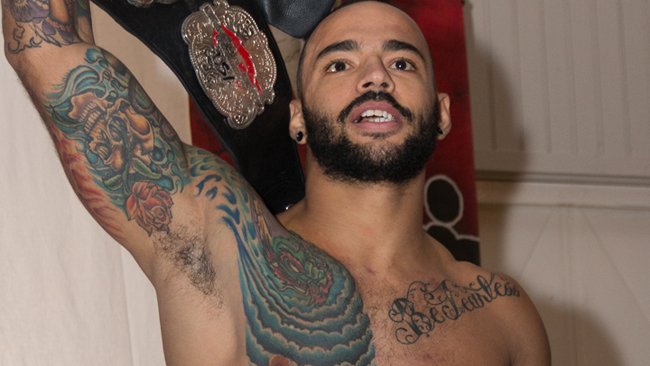
NEVER Openweight 6-Man Tag Team Championship
Four-Way Gauntlet Match
Four teams. Three guys on each team. The team left standing at the end walks out of Wrestle Kingdom with the 6-man titles!
In the first corner you have the current reigning champions, we’ll call them “Team New Japan”, made up of Ricochet, Satoshi Kojima and David Finlay. Ricochet is considered to be one the best high-flyers in the world (see: any of his matches with Will Ospreay) and works for Lucha Underground under a mask as Prince Puma. David Finlay is the son of wrestling legend Fit Finlay, and recently moved up as a Young Lion to a full-fledged member of the roster. He filled in for Matt Sydal after the recent controversy that landed Sydal in a Japanese prison, and is in his first reign with a New Japan title. And then there’s Satoshi Kojima, the veteran who was in his prime in the mid-2000s, holding both the world titles for All Japan and New Japan simultaneously in 2005. He was also a staple of the tag team division alongside long-time partner Hiroshi Tenzan, and while he has since been relegated to the lower midcard, Kojima is still very popular with fans.
In the second corner we have Bullet Club members Bad Luck Fale, Hangman Page and Yujiro Takahashi. Fale is the large enforcer of the group, and one of the Club’s founding members. Western fans may recognize the Hangman as Adam Page for his work in Ring of Honor; he has a noose he sometimes hangs his enemies over the ropes with. At 25 he has the potential to be a much bigger name in the future. Takahashi has been around for over a decade, pushed here and there in a couple different ways, but hasn’t really taken off consistently. He’s currently working a Godfather gimmick, complete with a “ho train” of attractive, scantily clad women that follow him around.
Representing Chaos is Jado, co-booker of New Japan and current booker man of Pro Wrestling Noah, the high-flying British sensation and Ring of Honor star Will Ospreay, and Yoshi-Hashi. While Hashi (jokingly referred to as “Tacos” by Shinsuke Nakamura) wasn’t seen as a major player, his career has really taken off in 2016 after a great series of programs, a showing in the G1 Climax and a swell of support from New Japan fans.
And finally, representing Testuya Naito’s Los Ingobernables de Japon faction, we have the team of Bushi, Evil and Sanada. These are three of the most promising talents in all of New Japan. Bushi represents LIJ in the juniors division, and has a promising future ahead of him as a possible mainstay replacement for Kushida one day. Evil, formerly known as Watanabe, was given a gimmick change upon returning to New Japan from an excursion in Ring of Honor. He is now the literally embodiment of evil, and carries a comically large scythe with him to the ring. His matches in the G1 were fantastic, and he promises to be one of the better heavyweight wrestlers in the next couple of years. Finally, Sanada has completely turned his career around since leaving TNA as a former X-Division champion, changing his look and putting on good matches consistently. With a bit more time working top stars, given his looks and natural talent, some are considering him as a future main eventer.
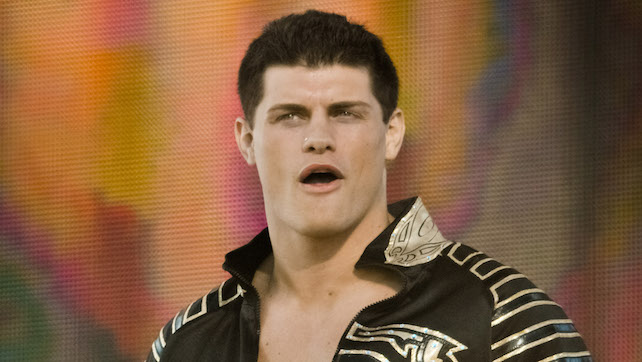
Cody Rhodes vs. Juice Robinson
Cody was recently announced as a member of the New Japan roster and the newest member of Bullet Club. He is now known as the “American Nightmare”, in a tribute to his father Dusty Rhodes, and will be making his debut at Wrestle Kingdom.
WWE fans may remember Juice Robinson as NXT developmental talent CJ Parker. While Parker didn’t really impress me with his gimmick in NXT, his year as a Young Lion on the New Japan roster has completely transformed him. Juice was promoted along with David Finlay to a full-time roster position in late 2016 after working the undercard of the G1 Climax, and has had the chance to work closely alongside Tanahashi since. His first singles match on a major show was against Kyle O’Reilly in September. This will also be his debut at Wrestle Kingdom, having worked as a member of the ring crew at the 2016 event.
I’m excited to see the reactions from WWE-specific fans who will get the chance to see the evolution of Cody since leaving the company, and a whole different wrestler than the rookie that left NXT as CJ Parker.
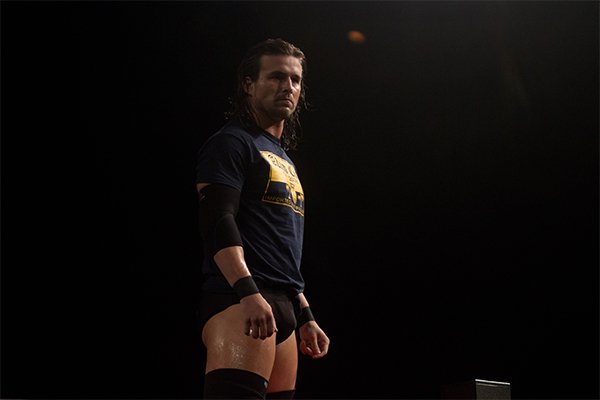
ROH World Championship
Kyle O’Reilly (c) vs. Adam Cole
If you haven’t been following the independent scene or Ring of Honor over the past few years, the careers of Kyle O’Reilly and Adam Cole have been inseparably linked.
The two started as tag team partners on the indies, which moved into PWG, then into Ring of Honor. It was Cole who became PWG Champion first, until O’Reilly defeated him for it in 2014 – that was just the beginning. During that time Cole was moving up the ranks in ROH, eventually becoming the top guy and ROH World Champion, while Kyle had expanded into other promotions and established one of the best tag teams in the world, reDragon, alongside Bobby Fish.
With both at their peak in 2016, Kyle defeated Cole at ROH Final Battle to finally capture the world title, ending the year atop the wrestling world having bested his greatest rival. The rematch was officially booked, the rivalry continued, and the title will be defended on New Japan turf at Wrestle Kingdom.
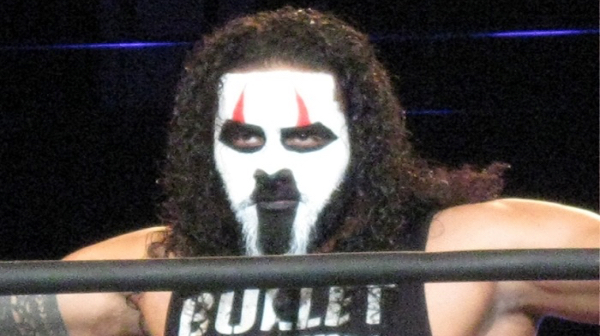
IWGP Tag Team Championship
Guerrillas of Destiny (c) vs. CHAOS vs. Great Bash Heel
As members of Bullet Club, Tama Tonga and his brother Tanga Loa are Guerrillas of Destiny (and yes, they call themselves “GoD” regularly), the current reigning IWGP Tag Team Champions. Tama is one of the founding members of the faction. He comes to the ring in face paint, and given his natural charisma, in-ring ability, Islander heritage, and the fact that he’s built like a Greek god, he could easily be a world champion in any promotion. Tanga Loa is former WWE Superstar Camacho. The duo had a rough start, wrestling lackluster matches as Loa struggled to find that vein of charisma his brother easily taps into, but in late 2016 things clicked. Loa has been completely different in tag team matches, taking down bigger stars, showing aggression, and actually carrying a bulk of the action. They are really just now hitting their stride together.
Great Bash Heel (or GBH) is the team of Togi Makabe and Tomoaki Honma. The duo of third generation strong-style experts won the 2016 World Tag League to earn their shot at the titles. Makabe is a legit tough guy, wearing big chains around his neck; he looks like the absolute last guy you’d want to get into a fight with at a bar. He is a former IWGP Heavyweight Champion, and in recent years has eased into his role as a midcard veteran that can still pull out incredible matches when necessary. Honma is the ultimate underdog character of New Japan, in that he’s a great wrestler but can’t ever seem to win the big one, despite fans constantly pushing for him. His match with Tomohiro Ishii in 2015 for the NEVER title is one of my all-time favorite matches.
Speaking of Ishii, he and wrestling’s greatest comedy character Toru Yano are representing the CHAOS faction, making this a triple threat match for the tag team titles. The two were inserted into the bout at the last minute, after winning a random tag team match at a house show, seemingly just to get them on the card, infuriating the champions due to their legitimate lack of claim on their titles. In response…Yano stole them. Then at the Wrestle Kingdom fan fest, during an in-ring segment to promote their bout, Yano stole GBH’s World Tag League trophies as well.
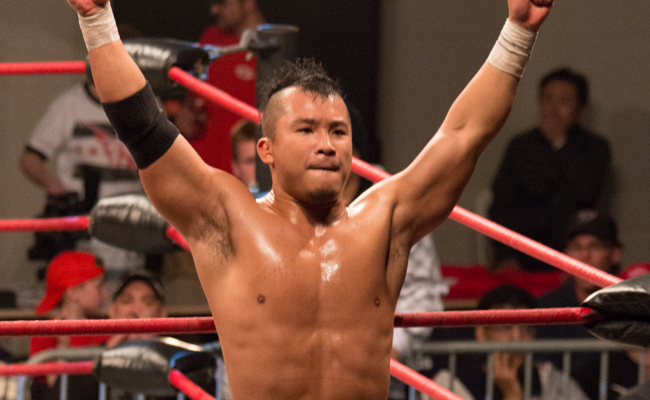
IWGP Jr. Heavyweight Championship
Kushida (c) vs. Himoru Takahashi
This should be really, really fun.
Kushida has been the ace of the New Japan junior division for the past several years, defeating every possible contender and carrying the belt all around the world, wrestling incredible matches over four title reigns. In addition to carrying the juniors in singles competition, Kushida also had a very successful tag team with Alex Shelley as the Time Splitters, winning the junior tag belts twice.
Admittedly, the juniors division has been a bit rocky at times over the last few years. While matches have been consistently great, and Kushida never fails to perform and get the fans behind him, the division has basically been a revolving door of whichever applicable stars were working for Ring of Honor at the time. Juniors rotate between challenging for the belts, or working in tag teams to challenge the Young Bucks – those that didn’t either moved up to the heavyweights, or left for other promotions. And while there were certainly great opponents to be found, there hasn’t been a consistent roster of dedicated challengers to really build things up. Because of that, Kushida has basically been relegated to tag team matches on major tours with allies, when not working dates for ROH.
Enter the return of Himoru Takahashi. Western fans may have seen his work in 2016 as Kamaitachi. He graduated from the New Japan Dojo in 2010 and paid his dues as a Young Lion throughout 2011 and 2012, competing in tournaments and working undercard tag team matches. It was felt at the time that Takahashi could be a major asset to the future of the juniors division, right around the time that Kushida was rising up and Prince Devitt (Finn Balor) was set to leave for WWE.
As is tradition, the promising rising star was sent on a learning excursion, first to various promotions across the UK, and then to the Mexican promotion CMLL. where he became a light heavyweight champion. While there, his matches with rival Dragon Lee (who also performed for ROH in late 2016) were incredible, talked about all around the world. It was clear that the former Young Lion was becoming a force to be reckoned with, but a return to New Japan was never publicly discussed.
At the finals of the G1 Climax, a mysterious vignette aired promising that a “Time Bomb” would explode by the end of 2016, with a count-down clock ending at the annual Power Struggle event in November. It was widely expected and even reported that the “Time Bomb” was to be the return of wrestling legend Minoru Suzuki and his stable Suzuki-Gun, who had been away for some time dominating Pro Wrestling Noah, a competing promotion that New Japan has/had a financial stake in. However, at Power Struggle (which was really an excellent show and you should check it out on World), moments after Kushida won back his IWGP Jr. Heavyweight Championship from Los Ingobernables de Japon member Bushi, the bomb exploded and a brand new, nearly unrecognizable Himoru Takahashi came walking down the ramp.
Sporting a throwback punk rock jacket and slicked-back hair freshly dyed a bright shade of red, Himoru showed off a new, frankly flamboyant charisma, getting right into the face of Kushida and even licking the IWGP championship. He’s odd, but in the best way. The challenge was thrown down, and the champion accepted. The next month, during the World Tag League finals, Himoru made his presence known at the end of a match pitting Kushida and Hiroshi Tanahashi against Tetsuya Naito and CMLL star Rush. In a move rarely seen inside a New Japan ring, he interfered in the match, laying waste to his Wrestle Kingdom opponent and, in one of the more unexpected moments of 2016, raised his fist to join forces with Los Ingobernables de Japon.
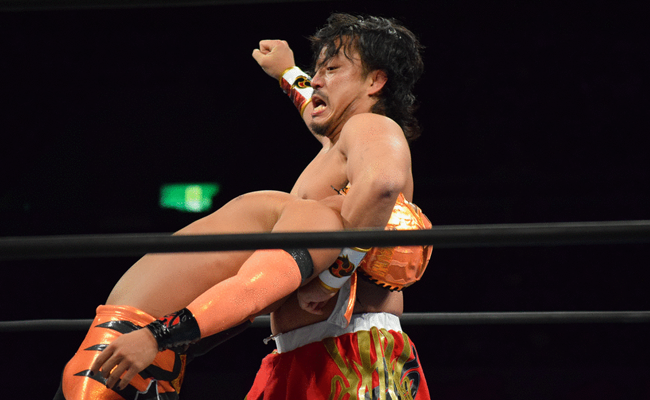
NEVER Openweight Championship
Katsuyori Shibata (c) vs. Hirooki Goto
Once upon a time there were three rookies molded from the same clay to be the future of pro wrestling in Japan; they were Hiroshi Tanahashi, Shinsuke Nakamura, and Katsuyori Shibata. In the early 2000s New Japan was crumbling, due in large part to some terrible creative choices made by founder Antonio Inoki and several other backstage forces within the promotion. Inoki wanted to take advantage of the massive popularity of MMA, and would book some of his top stars into shoot fights with world-class MMA fighters, which they would inevitably lose with rare exception, while simultaneously bringing in fighters to wrestle matches on New Japan cards.
Fans turned away in droves. Inoki was eventually outed from the company he created, but the damage had already been done. In the first year of rebuilding New Japan, buyrates for the annual Tokyo Dome show fell under 20,000 for the first time. Tanahashi and Nakamura were installed as the top stars of the promotion, but Shibata walked away.
In that time, Hirooki Goto rose up through the ranks to be a mainstay in the midcard of New Japan. But his career has personified the phrase “always the bridesmaid”, falling short of true main event status and the IWGP Heavyweight Championship. Even a surprise win in the 2008 G1 Climax, where he advanced to the finals over his own faction leader Shinsuke Nakamura, ultimately led to a defeat at the hands of Hiroshi Tanahashi. Eight times he tried his hand in matches for the world title, and eight times he came up short.
Shibata returned to New Japan in 2012, after working for rival promotions and attempting an ultimately lackluster career in MMA. Since his return, he and Goto have been linked on numerous occasions, carrying on a rivalry over many years that led to match after match, including a confrontation at Wrestle Kingdom 8 – the two even ran as a tag team, winning the IWGP titles, but losing them in their very first defense.
Shibata, while becoming one of the best wrestlers in the world and giving his body to New Japan in classic matches, has never reached the heights of his rookie counterparts Tanahashi and Nakamura that stayed behind through the bad times. It has created in him a lone wolf persona, angry and bitter, that in some ways transcends his character into real world drama between a world-class star that should have been a king, and the promotion never quite able to forgive him for leaving when they needed him most. And Goto has continued his quest to reach the top, even making it to the finals of the 2016 G1 Climax, but came up short once again, this time to Kenny Omega.
In a lot of ways this match represents a struggle for both men, who aspire to be at the top of New Japan, but are held back by their own personal demons. Two warriors, chained down by one another, looking desperately to shed their past. Shibata, who should have been world champion and seen in the same class as today’s modern legends, has been forced to elevate a second-rate title against aging veterans looking to keep their name relevant. Goto, so desperate to reach that platform that he joined the faction of a man who has bested him at every turn, the greatest in wrestling today, Kazuchika Okada.
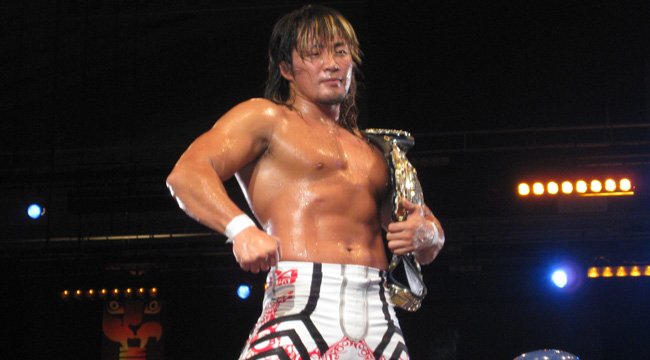
IWGP Intercontinental Championship
Tetsuya Naito (c) vs. Hiroshi Tanahashi
Simply put, Hiroshi Tanahashi was the Ace of New Japan who put the promotion on his shoulders and carried it back to success when the world thought it could not come back. It’s plausible that without him, there would be no New Japan today. He is one of the greatest professional wrestlers to have ever stepped inside a wrestling ring.
Tanahashi is a seven time IWGP Heavyweight Champion. In many ways the greatest champion in the history of New Japan. He holds the record. He has wrestled six matches rated a perfect five stars by the Wrestling Observer Newsletter. Two more than his greatest rival, Kazuchika Okada. Four more than Nakamura. Four more than Shawn Michaels. Three more than Bret Hart.
Until 2016, Tanahashi was the undisputed end-all, be-all of New Japan Pro Wrestling. Their names were synonymous. Eight times he has main evented the Tokyo Dome, and while Okada had been close behind for years, when it came time for Wrestle Kingdom he always walked out the champion. Until 2016. After two defeats in three years, Okada went into Wrestle Kingdom 10 as the IWGP Heavyweight Champion, determined to prove to the world that he had finally surpassed a living legend whose shadow he seemed eternally under. When Okada beat him, giving a beaten down and physically destroyed Tanahashi his first loss in the Dome in eight years, he became the new Ace.
Enter Tetsuya Naito. For many years Naito played the game as a babyface, winning tag team titles and midcard titles, but was never able to fully elevate himself to the true main event. There was always that “something extra” missing. I once heard him described during that period as “Tanahashi light”. Throughout 2015 he began expressing his frustrations, walking out on tag team partners, and showing ambiguity towards the fans. After a journey to Mexico, where he joined forces with the CMLL faction Los Ingobernables, Naito returned to New Japan with a new look and a new attitude – he turned his back on the fans and established what would go on to become the promotion’s most popular faction, Los Ingobernables de Japon.
By 2016 the legions of fans he felt had turned on him were back, cheering the apathetic villain, who now showed no emotion. In many ways, he is the nihilist of pro wrestling. He walks to the ring slowly, almost intentionally frustrating everyone around him. He will break free of holds and wrestling chains to pose in the middle of the ring, mocking his opponents with a cold, blank stare on his face. Many fans love him, and crowds are often a sea of LIJ merchandise, but nothing seems to matter. Nothing any opponent says reaches him, and in response he offers apathy and disinterest for their legacies.
2016 was the year of Naito. He defeated Kazuchika Okada, the new Ace of the promotion, to become IWGP Heavyweight Champion. Later in the year he won the Intercontinental Championship as well; the belt that Nakamura made famous. He had symbolically bested two of the men whose shadows he felt he lived under, and Tanahashi was his final goal. But in defeating Tanahashi at Wrestle Kingdom 10, Naito feels that Okada took that victory away from him. It was Okada who ended the greatness of the best in the world, not him. In a recent interview promoting Wrestle Kingdom, he said the following:
“When I debuted, nobody was watching me. And I thought ‘I have to overtake Tanahashi’. That was my duty. I said to myself over and over, like a mantra. And I’ve done that now, but it wasn’t me that did it. It was Okada in 2016. He overtook Tanahashi. From there he faded away. I was the one that wanted to do that to him, but Okada did.
“I always hoped for that big match. The biggest stage, both at our primes. I think that chance has gone, which is a shame. Maybe I ascended too slowly, or he fell away too quickly. But this match isn’t that. I see nothing in this match that interests me. I can see it’s a match with a lot of value for him, but it does nothing for me. So I have to look for motivation. And if the pleasure of overtaking Tanahashi myself, if that is denied me, well then I’ll just have to take pleasure in driving the final nail home in his career.”
Tanahashi, who was largely out of the spotlight in 2016 for the first time in a decade, sees this match at Wrestle Kingdom as potentially his last chance to get back to the main event. His main event. And Naito knows that.
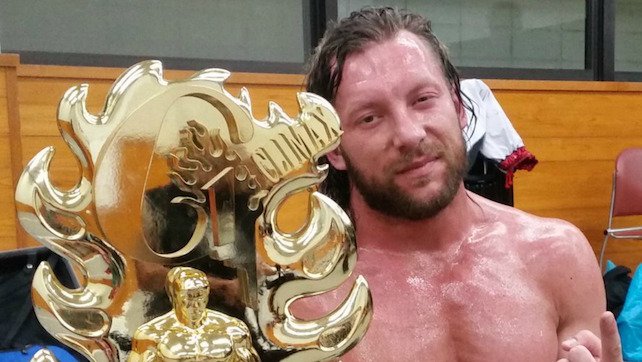
IWGP Heavyweight Championship
Kazuchika Okada (c) vs. Kenny Omega
As we’ve already discussed, Okada is the new Ace of the company having finally defeated Tanahashi in the Tokyo Dome, and regaining his championship from Naito halfway through 2016.
When he broke into New Japan as a young up-and-comer, Okada was immediately spotted as the future of wrestling. I’ve heard the comparisons to Randy Orton dozens of times – that if you could build your perfect pro wrestler, with all the natural ability, grasp of the industry, charisma, charm, and downright sex appeal, it would be Randy Orton. That’s what people saw when they looked at Kazuchika Okada. But during the late 2000s, New Japan was rebuilding the promotion on the backs of Tanahashi and Nakamura; there wasn’t much room left at the very top for someone of that magnitude, without risking the drawing power of the others. And so, as they do, they sent him on an excursion overseas to develop his abilities with TNA.
TNA’s mishandling of Okada might be one of their biggest blunders, ever. Instead of treating him like a star, or a future world champion, he was kept off major cards and relegated to dark matches and B-show footage. Essentially he sat useless on the roster; a diamond any promoter could have built an empire around, but TNA did nothing. He was supposed to take as long as three years in America, with the hope that he would return a major star with a fully formed gimmick they could shotgun into the main event. He was back in nine months.
When he came back, Okada brought with him an idea: a young, cocky protege who knew his worth and wasn’t afraid to flaunt it in the faces of his opponents. He donned bright, floor-length coats and literally dropped money with his face printed on it from the rafters. The Rainmaker was born. He returned at Wrestle Kingdom, and in a move nearly unprecedented in New Japan, walked right up to Tanahashi following his successful main event title defense, and declared himself the next champion. He won the belt within a month. In that time he also joined forces with the faction CHAOS, a villainous team built by Shinsuke Nakamura to resurrect the old art of strong-style. When Nakamura left, the team became his, and the rest is history.
Kenny Omega is a very different story. Older than Okada, with more experience in the wrestling business, Omega honed his craft on the U.S. independents before entering the Japan scene as a member of the DDT Pro roster. Over the years he became a mainstay in the promotion, which had a much more western influence than New Japan, allowing some of the most outlandish and ridiculous segments you’ll ever see in a wrestling ring. You may recall a wrestler fighting a 9-year-old girl circulating around the internet; that was Kenny Omega. His long-time tag team partner and greatest rival Kota Ibushi also wrestled a blow-up doll for DDT around the same time.
When he arrived in New Japan, he and Ibushi rose up the ranks of the juniors division while maintaining a presence in various other promotions. Over the first few years he reached high enough to receive opportunities at the IWGP juniors title, but was thwarted each time, ironically by the man that would go on to found Bullet Club, Prince Devitt (Finn Balor). 2015 was a turning point for his career. While most gaijins tend to play heels, giving native Japanese wrestlers easy targets to beat down, Kenny was always a fun-loving babyface and didn’t consider himself to be a foreigner. Japan was his home by this point, and he was fluent in the language. When he officially signed a contract to become a full-time member of the New Japan roster, he fooled everyone by joining Bullet Club, and refused to speak in anything but English to infuriate the fans that had loved him.
In his first match as a Bullet Club member, Omega won the IWGP Jr. Heavyweight Championship at Wrestle Kingdom 9. He spent most of 2015 feuding in the division with Kushida, while aiding his faction members in matches and working his way up the roster. After a loss at Wrestle Kingdom 10, Omega declared that he was finished with the juniors. One night later, Bullet Club turned on AJ Styles, who was set to leave for WWE, and it was Kenny Omega who took his place as the leader of the world’s greatest stable.
One month after becoming the head of Bullet Club and graduating to the heavyweight division, Omega defeated Hiroshi Tanahashi to win the Intercontinental Championship in the wake of Shinsuke Nakamura leaving the promotion. He then brought the first ladder match in history to New Japan, in a title defense against fellow Canadian Michael Elgin. With all the pieces in place for his ascension to the main event, he entered the G1 Climax…and won. On his way to victory, Omega wrestled a five-star match (the first of his career) against Tetsuya Naito, upsetting the hottest heel in wrestling in the semi-finals of the tournament. In doing so, he became the first foreigner in history to win the G1. And he did so using the finishing moves of every soul he had collected along the path: Kota Ibushi, Shinsuke Nakamura, Prince Devitt, and AJ Styles.
He had the accolades, he had the faction, he had the spotlight – the only thing left was to issue the challenge: Kenny Omega vs. Kazuchika Okada, the Ace of New Japan Pro Wrestling, for the IWGP Heavyweight Championship in the main event of Wrestle Kingdom 11.
The dynamics of this match cannot be understated. Kenny’s year in 2016 was flawless, rising from the juniors division to the head of Bullet Club, to making history multiple times, to main eventing the Tokyo Dome. In a year where the promotion lost AJ Styles, Karl Anderson, Luke Gallows, Shinsuke Nakamura and Kota Ibushi, in the same year that Hiroshi Tanahashi faded from the spotlight, it was Kenny Omega who rose up to fill the empty void. It’s been said that New Japan would never pull the trigger on a foreigner winning the G1 Climax if he wasn’t going to win the title in the Dome.
But Okada complicates things. He is the current Ace of the promotion. He’s the top draw. He is the main event, and this is his very first Wrestle Kingdom in that role. For the first time, New Japan is looking to him instead of Hiroshi Tanahashi. So what would it say if, in his first defense inside the Tokyo Dome, he lost? And not to Tanahashi. Not even to Naito. But to a foreigner. To the leader of a faction full of foreigners. To the leader of a faction whose history is full of world-class stars that have abandoned the promotion for WWE. To the man who refused to plant the G1 flag as is tradition, following his win, but instead threw it on the ground and planted the Bullet Club flag in its place…
So what happens when the greatest rising star of 2016 meets the king of the promotion on their biggest stage in history, for the biggest prize in wrestling? I guess we’ll find out tonight.
